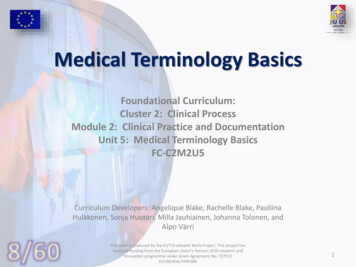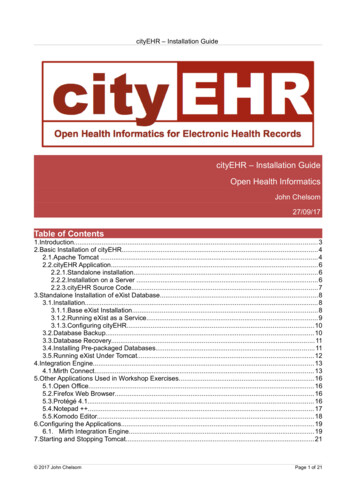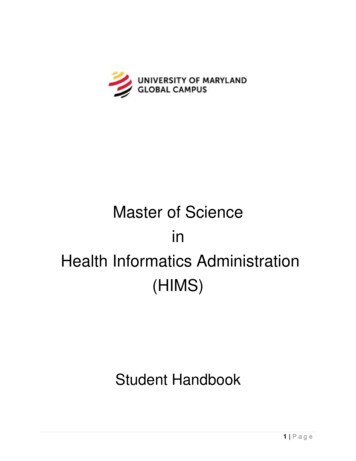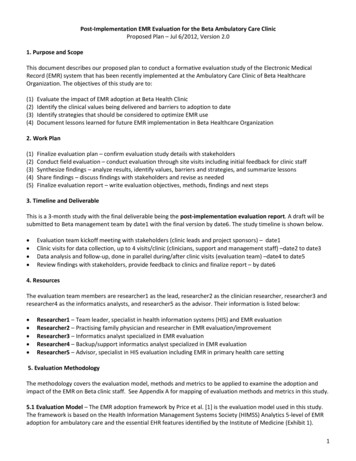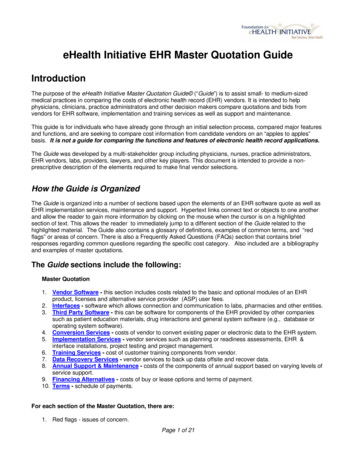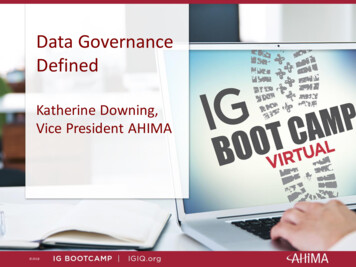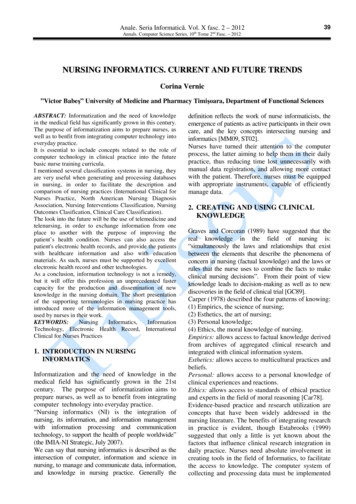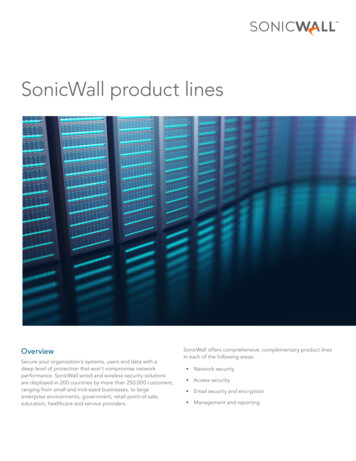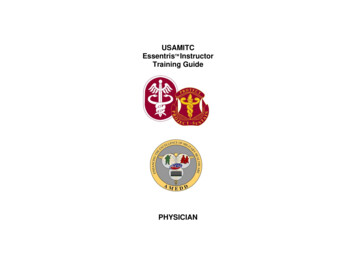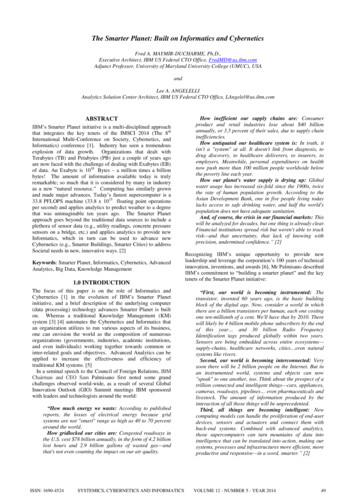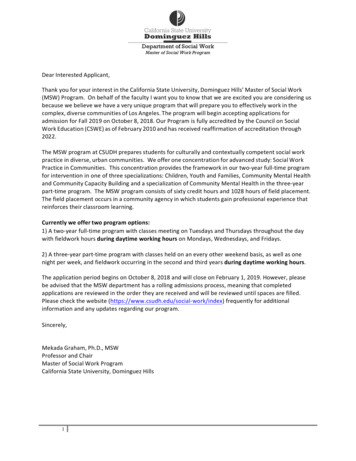
Transcription
Health Informatics BasicsFoundational Curriculum:Cluster 4: InformaticsModule 7: The Informatics Process and Principles of HealthInformaticsUnit 1: Health Informatics BasicsFC-C4M7U1Curriculum Developers: Angelique Blake, Rachelle Blake, PauliinaHulkkonen, Sonja Huotari, Milla Jauhiainen, Johanna Tolonen, andAlpo Vӓrri20/60This work is produced by the EU*US eHealth Work Project. This project hasreceived funding from the European Union’s Horizon 2020 research andinnovation programme under Grant Agreement No. 727552EUUSEHEALTHWORK1
Unit Objectives Define health informatics Describe the two sub-disciplines of healthinformatics Identify nine different types of related informaticsdisciplines used in healthcare and state thevarious definitions of informatics within thehealth sector Identify key informatics concepts, models andtheories Describe the importance of informatics in activeand healthy ageingFC-C4M7U1This work is produced by the EU*US eHealth Work Project. This project hasreceived funding from the European Union’s Horizon 2020 research andinnovation programme under Grant Agreement No. 727552EUUSEHEALTHWORK2
Health Informatics Informatics is the union of information, people andscience/process/technology Health informatics is the interdisciplinary study of the design,development, adoption, and application of information andtechnology-based innovations in public health and healthcareservices delivery, management, and planning Health informatics is often used to describe the full range ofapplication and research topics for which biomedicalinformatics is the pertinent underlying scientific disciplineFC-C4M7U1This work is produced by the EU*US eHealth Work Project. This project hasreceived funding from the European Union’s Horizon 2020 research andinnovation programme under Grant Agreement No. 727552EUUSEHEALTHWORK3
Health Informatics Subsets Health Informatics is the overarching theme for all informatics used inhealthcare. The two main sub-disciplines are:– Clinical Informatics– Population Health InformaticsOther subsets of Health Informatics l informatics (MI)Public Health informaticsConsumer health informaticsNursing informatics (NI)Dental InformaticsNutrition InformaticsPharmacy InformaticsBiomedical informaticsTranslational bioinformaticsComputational health informatics (CHI)Clinical research informatics (CRI)Informatics in Active and Healthy Ageing*All informatics definitions in this unit have been developed and validated in conjunction with the HIMSS TIGERCommittee and its Informatics Definitions DocumentFC-C4M7U1This work is produced by the EU*US eHealth Work Project. This project hasreceived funding from the European Union’s Horizon 2020 research andinnovation programme under Grant Agreement No. 727552EUUSEHEALTHWORK4
Clinical Informatics Clinical informatics* is a subset of healthinformatics used by clinicians in theapplication deliver healthcare services It blends information technology into clinicalcare processes, usually within a health system It is also referred to as applied clinicalinformatics and operational informaticsHEALTH CHNOLOGY– Clinical informatics includes a wide range oftopics ranging from clinical decision support tovisual images (e.g., radiological, pathological,dermatological, ophthalmological, etc.); fromclinical documentation to provider order entrysystems; and from system design to systemimplementation and adoption issuesFC-C4M7U1This work is produced by the EU*US eHealth Work Project. This project hasreceived funding from the European Union’s Horizon 2020 research andinnovation programme under Grant Agreement No. 727552EUUSEHEALTHWORK5
Public, Consumer and Population HealthInformatics Public Health informatics is the field that optimizes the use of information toimprove individual health, health care, public health practice, biomedical andhealth services research, and health policy.–PHI operates at the intersection of public health and computer science. It relies on information technology(IT) systems to help address the core functions of public health as defined by the Institute of Medicine:assessment of population health, policy development, and assurance of the availability of high-qualitypublic health services. It is thus related to but distinct from biomedical and clinical informatics, which seekto improve the health of individuals within the health care system. Consumer health informatics analyses consumers’ needs for information;studies and implements methods of making information accessible toconsumers; and models and integrates consumers’ preferences into medicalinformation systems.–Consumer informatics stands at the crossroads of other disciplines, such as nursing informatics, publichealth, health promotion, health education, library science, and communication science it is paving theway for health care in the information age. It helps bridge the gap between patients and health resources.It looks at informatics from multiple consumer or patient views.FC-C4M7U1This work is produced by the EU*US eHealth Work Project. This project hasreceived funding from the European Union’s Horizon 2020 research andinnovation programme under Grant Agreement No. 727552EUUSEHEALTHWORK6
Public, Consumer and Population HealthInformatics Population health is defined as the health outcomes of agroup of individuals, including the distribution of suchoutcomes within the group. Therefore, Population HealthInformatics is the intersection of public health informatics andconsumer informatics. It is the systematic study of populations viasecondary analysis of massive data collections (called "big data")about people. Population informatics applies data science to social genome data to answerfundamental questions about human society and population– It is an emerging research area at the intersection of SBEH (Social, Behavioral, Economic andHealth) sciences, computer science, and statistics– It involves using quantitative methods and computational tools to answer fundamentalquestions about populations– These groups are often geographic populations such as nations or communities, but can also beother groups such as employees, ethnic groups, disabled persons, prisoners, or any otherdefined group. The health outcomes of such groups are of relevance to policy makers in boththe public and private sectors.FC-C4M7U1This work is produced by the EU*US eHealth Work Project. This project hasreceived funding from the European Union’s Horizon 2020 research andinnovation programme under Grant Agreement No. 727552EUUSEHEALTHWORK7
Public, Consumer and Population HealthInformatics Note that population health is not just the overall health of apopulation but also includes the distribution of health.Overall health could be quite high if the majority of the population isrelatively healthy—even though a minority of the population is muchless healthy.Ideally such differences would be eliminated or at least substantiallyreduced.FC-C4M7U1This work is produced by the EU*US eHealth Work Project. This project hasreceived funding from the European Union’s Horizon 2020 research andinnovation programme under Grant Agreement No. 727552EUUSEHEALTHWORK8
Medical InformaticsIn addition to clinical informatics and publichealth informatics, the following disciplines ofinformatics are related to healthcare: Medical informatics (MI) is the interdisciplinarystudy of the design, development, adoption andapplication of IT-based innovations in healthcareservices delivery, management and planning– It can also be described as the field of informationscience concerned with the analysis, use anddissemination of medical data and informationthrough the application of computers to variousaspects of health care and medicine.– Medical informatics is also frequently used to describethe informatics field in which physicians specializeFC-C4M7U1This work is produced by the EU*US eHealth Work Project. This project hasreceived funding from the European Union’s Horizon 2020 research andinnovation programme under Grant Agreement No. 727552EUUSEHEALTHWORK9
Nursing Informatics Nursing informatics (NI) is the specialty thatintegrates nursing science with multipleinformation management and analyticalsciences to identify, define, manage, andcommunicate data, information, knowledge,and wisdom in nursing practice– NI supports nurses, consumers, patients, theinterprofessional healthcare team, and otherstakeholders in their decision-making in all rolesand settings to achieve desired outcomes. Thissupport is accomplished through the use ofinformation structures, information processes, andinformation technologyFC-C4M7U1This work is produced by the EU*US eHealth Work Project. This project hasreceived funding from the European Union’s Horizon 2020 research andinnovation programme under Grant Agreement No. 727552EUUSEHEALTHWORK10
Dental, Nutrition and PharmacyInformatics Dental informatics is the application of computer andinformation science to improve dental practice,research, education and management. The field ofdental informatics is concerned with the intersection ofhealth informatics and dentistry as a whole Nutrition informatics is the effective retrieval,organization, storage and optimum use of information,data and knowledge for food and nutrition-relatedproblem solving and decision-making Pharmacy informatics the scientific field that focuseson medication-related data and knowledge within thecontinuum of healthcare systems - including itsacquisition, storage, analysis, use and dissemination - inthe delivery of optimal medication-related patient careand health outcomesFC-C4M7U1This work is produced by the EU*US eHealth Work Project. This project hasreceived funding from the European Union’s Horizon 2020 research andinnovation programme under Grant Agreement No. 727552EUUSEHEALTHWORK11
Biomedical and Translational Informatics Biomedicine is medicine based on the application of theprinciples of the natural sciences, especially biology andbiochemistry Biomedical informatics is the interdisciplinary field thatstudies and pursues the effective uses of biomedical(relating to biomedicine) data, information, andknowledge for scientific inquiry, problem solving, anddecision-making, driven by efforts to improve humanhealth1– Bioinformatics: is used to develop tools and methods (usually software) forunderstanding biological data is related to research in molecular biology can include fields from signal processing to biology, combiningstatistical and mathematical techniques to compute resultsFC-C4M7U1This work is produced by the EU*US eHealth Work Project. This project hasreceived funding from the European Union’s Horizon 2020 research andinnovation programme under Grant Agreement No. 727552EUUSEHEALTHWORK12
Biomedical and Translational Informatics Translational Bioinformatics is the development ofstorage, analytic, and interpretive methods to optimizethe transformation of increasingly voluminous biomedicaldata, and genomic data, into proactive, predictive,preventive, and participatory health. Translational bioinformatics includes research on thedevelopment of novel techniques for the integration ofbiological and clinical data and the evolution of clinicalinformatics methodology to encompass biologicalobservations. The end product of translational bioinformatics is newlyfound knowledge from these integrative efforts that canbe disseminated to a variety of stakeholders, includingbiomedical scientists, clinicians, and patients.FC-C4M7U1This work is produced by the EU*US eHealth Work Project. This project hasreceived funding from the European Union’s Horizon 2020 research andinnovation programme under Grant Agreement No. 727552EUUSEHEALTHWORK13
Computational Health Informatics Computational health informatics (CHI)specifically integrates computer sciencetechniques that are relevant in healthcare.Healthcare provides an extremely widevariety of problems that can be tackled usingcomputational techniques. Informaticists inthis area study the underlying principles ofcomputer science that allow for medicallyrelated algorithms and systems to bedeveloped. This subspecialty of healthinformatics frequently analyse “big data”. Itinvolves health and computer scientistsworking in unison to develop the nextgeneration of healthcare technologiesthrough computational informaticsFC-C4M7U1This work is produced by the EU*US eHealth Work Project. This project hasreceived funding from the European Union’s Horizon 2020 research andinnovation programme under Grant Agreement No. 727552EUUSEHEALTHWORK14
Clinical Research Informatics Clinical research informatics (CRI) is anamalgamation of clinical and researchinformatics, plays an important role inclinical research, patient care, and thebuilding of healthcare system. It is oneof the rapidly growing subdivisions ofbiomedical informatics. It plays animportant role in developing newinformatics theories, tools andsolutions. Clinical research informaticsapplies the core foundations,principles, and technologies of healthinformatics to clinical researchFC-C4M7U1This work is produced by the EU*US eHealth Work Project. This project hasreceived funding from the European Union’s Horizon 2020 research andinnovation programme under Grant Agreement No. 727552EUUSEHEALTHWORK15
Health Informatics VisualizedFC-C4M7U1This work is produced by the EU*US eHealth Work Project. This project hasreceived funding from the European Union’s Horizon 2020 research andinnovation programme under Grant Agreement No. 727552EUUSEHEALTHWORK16
Informatics Concepts Information Architecture (IA) is thestructural design of shared informationenvironments. It is a crucial componentin the development of healthcaretechnology systems, applications users– Informaticists play a part in helpin
HEALTH SYSTEM INFORMATION TECHNOLOGY CLINICAL CARE CLINICAL INFORMATICS. Public, Consumer and Population Health Informatics Public Health informatics is the field that optimizes the use of information to improve individual health, health care, public health practice, biomedical and health services research, and health policy. – PHI operates at the intersection of public health and .
